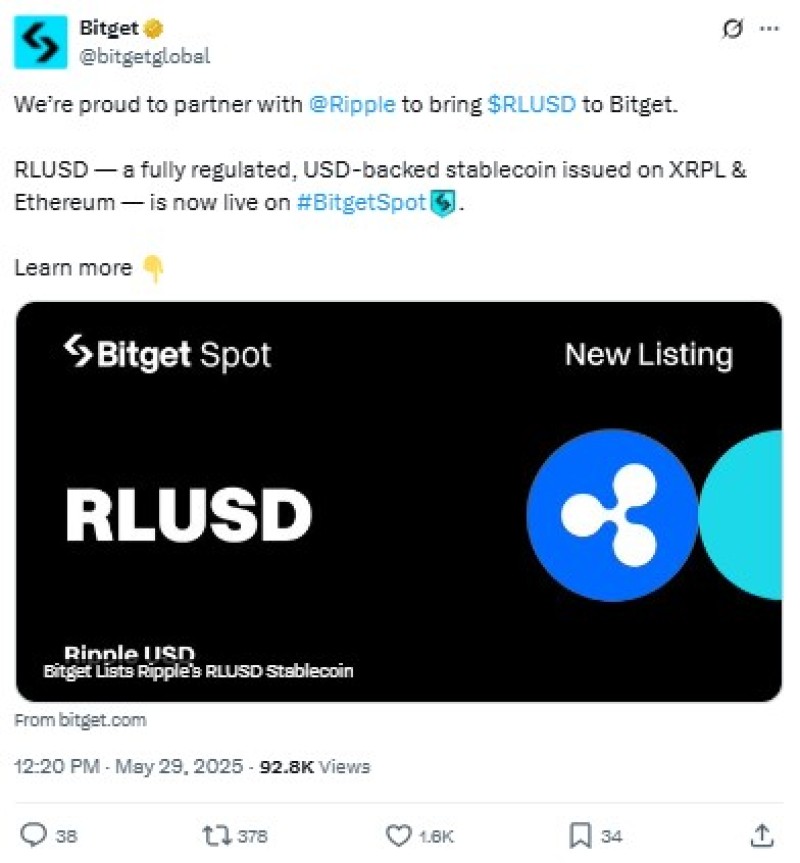Ripple's RLUSD stablecoin just landed on Bitget, and while that might sound like just another crypto listing, this one's actually pretty significant. We're talking about access to over $7.1 billion in assets and daily trading volumes that hit $3.4 billion.
So RLUSD Made It to Bitget - What's the Big Deal?
Okay, so another day, another stablecoin listing, right? Wrong. This isn't your typical "hey look, we're on another exchange" announcement. When Ripple USD (RLUSD) gets listed on a platform like Bitget, it's actually worth paying attention to.
Here's why: Bitget isn't some random crypto exchange trying to pump their token count. This is a serious platform handling real money - we're talking $7.1 billion in total assets and over $3.4 billion moving through their spot trading every single day. That's not monopoly money.
RLUSD isn't just another "trust us, we have dollars somewhere" stablecoin either. This thing is backed 1:1 by actual USD reserves sitting in real bank accounts and cash equivalents. Plus, it runs on both XRP Ledger and Ethereum, which means you're not stuck picking sides in some blockchain turf war.
What really sets this apart is the regulatory stuff. I know, I know - regulation sounds boring, but hear me out. RLUSD comes from a NYDFS-chartered trust company, which in plain English means New York's financial regulators actually looked at this thing and said "yeah, this is legit." In today's crypto climate, that's like having a golden ticket.
How's Ripple USD Actually Performing Right Now?
Let's talk numbers because that's what really matters. You can trade RLUSD against both USDT and USDC on Bitget now, which is pretty much the standard setup you'll find on other major platforms like Kraken, Uniswap, and Bitstamp.
The token is trading right at $1.00 - exactly where a dollar-pegged stablecoin should be. Its market cap is sitting around $309 million with daily trading volume pushing over $63 million. That might not sound massive compared to Tether's dominance, but for a relatively new player, those are solid numbers.
What's encouraging is that the peg is holding steady even as trading volume picks up. When stablecoins start getting real volume, that's usually when you see if they can actually maintain their dollar peg or if cracks start showing. So far, RLUSD is passing that test.
The fact that people are actually trading this thing - not just holding it and forgetting about it - tells you there's genuine demand. Traders are using it for arbitrage, DeFi protocols are starting to integrate it, and institutions are taking notice.
What Happens Next for RLUSD?
This Bitget listing is reportedly RLUSD's fourth major exchange listing in 2025, which shows they're building momentum systematically rather than trying to be everywhere at once. Smart approach, really.
The real test is going to be whether RLUSD can build enough liquidity to become actually useful for the things people do with stablecoins - trading, DeFi, cross-border payments, all that stuff. Having regulatory approval is great, but if your token doesn't have enough volume to matter, compliance doesn't help much.
What's encouraging is that Bitget seems to be treating this as a serious integration, not just adding another token to their list. When they announce full withdrawal support starting May 30th, that tells you they expect real volume and are willing to put their infrastructure behind it.
According to Bitget's CEO Gracy Chen, this listing fits into their 2025 plan to expand offerings for institutional traders. That suggests we might see more enterprise-focused features and partnerships coming down the road.

Bottom Line on RLUSD
Look, I'm not saying RLUSD is going to flip Tether or revolutionize crypto overnight. But getting listed on an exchange that handles $7.1 billion in assets isn't nothing. In crypto, distribution matters more than almost anything else, and RLUSD is building its distribution network one solid partnership at a time.
The boring approach might actually work here. While other stablecoins are chasing yield farming schemes and flashy marketing campaigns, RLUSD is focused on the fundamentals: maintaining its peg, building liquidity, and staying compliant with regulators.
Whether that's enough to carve out a meaningful piece of the stablecoin market remains to be seen. But in a space where most projects flame out after their initial hype cycle, taking the steady, professional approach might not be such a bad strategy after all.
 Saad Ullah
Saad Ullah

 Saad Ullah
Saad Ullah


